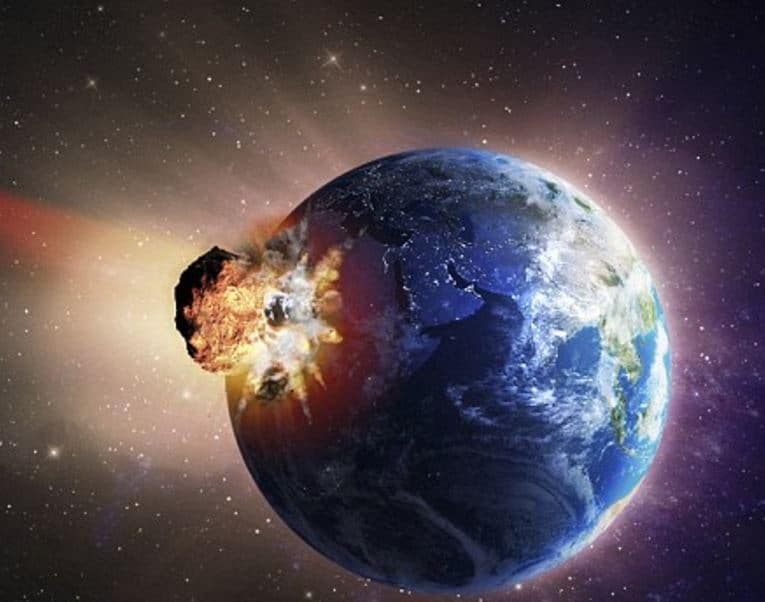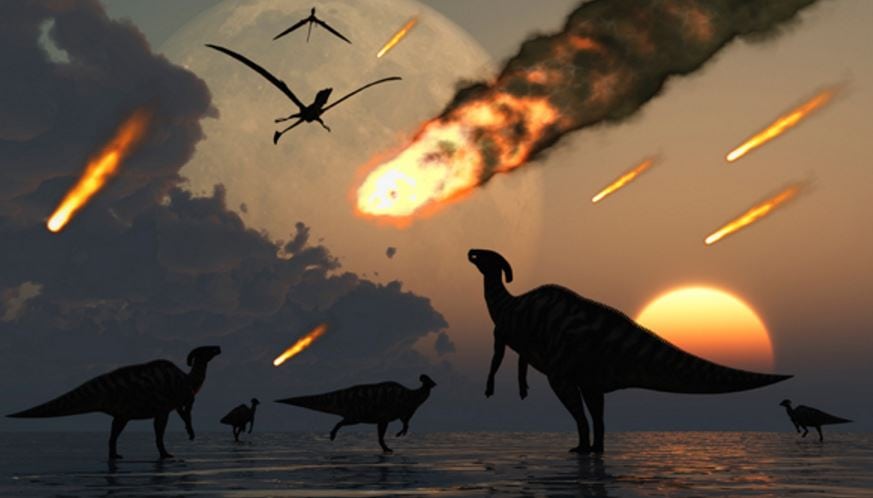A giant comet that could wipe us out hits the Earth once every 40,000 to 100,000 years, says a group of British scientists. The impact would throw so much dust and moisture into the atmosphere that it would cut off sunlight, send temperatures crashing globally, and gradually kill off all life. Over the past twenty years, hundreds of centaurs (giant comets) have been detected in the outer parts of our solar system.
Professor Mark Bailey and Dr. David Asher from Armagh Observatory in Northern Ireland, Bill Napier, Honorary Professor at the Buckingham Centre for Astrobiology, and Professor Duncan Steel, Professor of Astrobiology at the University of Buckingham, England and Astronomer at the Armagh Observatory, wrote about their latest study and findings in the journal Astronomy & Geophysics, a publication of the Royal Astronomy Society.
The orbits of these mega-comets are unstable. When they cross the paths of the outer planets – Jupiter, Saturn, Neptune and Uranus – their gravitational pull alters the route of their orbits, sometimes pulling them directly towards the Earth.
 An artist’s impression of a large celestial object hitting the Earth. A much smaller giant-comet fragment could wipe us all out.
An artist’s impression of a large celestial object hitting the Earth. A much smaller giant-comet fragment could wipe us all out.
Giant comets don’t hit Earth intact. They usually break up into pieces as they get closer. However, their fragments are still big enough to destroy us all if they struck our planet.
Some centaurs are really large
Centaurs are really big comets, giant balls of ice and dust, generally between 31 and 61 miles (50 and 100 kilometres) across – even larger ones have been spotted. Just a single centaur is larger than the combined mass of all the Earth-crossing asteroids we know of.
The scientists worked out, after gathering data on all comets we know of out there, and the gravitational pulls of the planets in our solar system, that Earth gets a major giant-comet impact about once every 40,000 to 100,000 years.
While whizzing into the inner part of our Solar System – where Earth is – these giant objects are expected to disintegrate into fragments, rocks and dust, filling the inner solar system with huge amounts of debris. One of them is bound to hit Earth, the authors wrote – it is inevitable.
According to our knowledge of interplanetary matter in near-Earth space, and what archeologists and geologists know about Earth’s history, our planet was last struck by a huge object about thirty thousand years ago.
A centaur would have broken up, sending fragments and dust into the inner planetary system. Some of these fragments would still have been pretty big – at least several miles across.
Just a one-mile-wide body, which could be travelling at 30,000 miles per hour, would have the energy roughly equal to a 1 million megaton bomb when it hit Earth’s surface. This would be the equivalent of the atomic bomb that was dropped on Hiroshima in Japan in 1945 multiplied by 66 million. Imagine what a body at least 2 miles wide would do.
 At the centre of this map is the sun, and closest to it the small orbits of the terrestrial planets (Mars, Earth, Venus and Mercury). The bright blue lines represent the near-circular paths of the giant planets: Neptune, Uranus, Saturn and Jupiter. Pluto’s is shown in white. The trans-Neptunian objects (TNOs) remain perpetually beyond Neptune, in yellow: seventeen TNO orbits are shown here, with the total discovered population at present being over 1,500. The orbits of 22 Centaurs (out of about 400 known objects) are shown in red, and these are essentially giant comets. Their orbits are unstable. (Image: www.ras.org.uk)
At the centre of this map is the sun, and closest to it the small orbits of the terrestrial planets (Mars, Earth, Venus and Mercury). The bright blue lines represent the near-circular paths of the giant planets: Neptune, Uranus, Saturn and Jupiter. Pluto’s is shown in white. The trans-Neptunian objects (TNOs) remain perpetually beyond Neptune, in yellow: seventeen TNO orbits are shown here, with the total discovered population at present being over 1,500. The orbits of 22 Centaurs (out of about 400 known objects) are shown in red, and these are essentially giant comets. Their orbits are unstable. (Image: www.ras.org.uk)
Palaeontologists (fossil experts) and geologists know about specific occurrences about 2,300 BCE and 10,800 BCE, which support our new understanding of cometary populations. (BCE – Before Common Era – is a secular term. Chronologically, it means the same as BC).
Giant comets likely linked to mass extinctions
Earth has witnessed some devastating mass extinctions, such as the end of the dinosaurs 65 million years ago. The authors believe they are likely linked to this giant comet hypothesis.
Regarding our study of comets, giant comets and asteroids, Prof. Napier said:
“In the last three decades we have invested a lot of effort in tracking and analysing the risk of a collision between the Earth and an asteroid. Our work suggests we need to look beyond our immediate neighbourhood too, and look out beyond the orbit of Jupiter to find centaurs.”
“If we are right, then these distant comets could be a serious hazard, and it’s time to understand them better.”
 The dinosaurs ruled the Earth until a large celestial object crashed, and wiped them all out.
The dinosaurs ruled the Earth until a large celestial object crashed, and wiped them all out.
The researchers also unearthed evidence from different fields of science that supported their model.
For instance, tiny craters detected in lunar rocks, which were brought back to Earth during the Apollo missions, are mostly younger than 30,000 years. Since that time, there has probably been a huge increase in the about of space debris building up in the inner Solar System.
Many scientists suggest that a massive comet bombardment, or a series of impacts, may have triggered life on Earth by bringing organic molecules and water. It is ironic that what probably brought life to our planet, may one day take it away.
Reference: “Centaurs as a hazard to civilization,” Bill Napier, Duncan Steel, David Asher and Mark Bailey. Astronomy and Geophysics. December 2015. DOI: 10.1093/astrogeo/atv198.
Video – Giant comets could strike Earth any time and destroy us
A giant comet could go off course, pulled in by the gravity of one of the larger outer planets, and come directly towards Earth and hit us.

